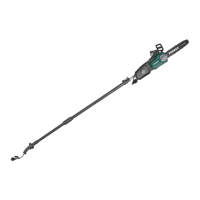25
2-in-1 Chainsaw with Telescopic Pole
AFTER SALES SUPPORT
e-mail: info.aldi@positecgroup.com
1300 889 028
MODEL: N
o
. 705156 · 03/2021 · GCS250F
(toll free)
AFTER SALES SUPPORT
(toll free)
e-mail: info.aldi@positecgroup.com1300 889 028
MODEL: N
o
. 705156 · 03/2021 · GCS250F
1. Clear the area around the tree and make sure that you have a good foothold
and clear retreat path.
2. Ensure that others in the area are aware of the felling and ensure people and
animals are well clear.
3. Make a notch cut one-third of the way into the tree on the felling side.
4. Make the felling cut on the opposite side to the initial notch and slightly
higher than the notch. As the felling cut gets close to the notch cut, the tree
will begin to fall.
5. Remove the chainsaw from the cut, and stop the engine with the on/o
switch, put the chainsaw down and leave the area along the retreat path.
Limbing (Fig L)
Limbing is the process of removing the branches from
a fallen tree.
Check the direction in which a branch will bend
before cutting it. Always cut on the opposite side to
the bending direction so that the guide bar (7) is not
pinched in the cut.
For large limbs that cannot be removed in one cut, make an initial cut from the
bent side and nish by sawing from the opposite direction.
Do not remove limbs that are supporting the fallen tree on the ground until the
tree has been cut into lengths.
WARNING:
Always keep a balanced stance. Do not stand on the log.
Be alert to the fact that the log may roll over. When working on a
slope, always stand on the uphill side of the log.
Bucking (Fig M)
Bucking is cutting a log into lengths for easier
handling.
To saw a log lying on the ground, rst saw halfway,
then roll the log over and cut from the opposite side.
To saw the end of a log supported o the ground,
rst saw up from the bottom one-third through the
1
2
L
1
2
1
2
M

